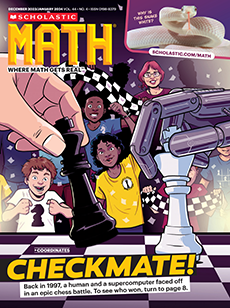Play the instructional video. At certain points, pause the video to discuss the following questions:
• At 0:34, ask: Why is 50 the dividend and 16 2/3 the divisor? (50 is the total length of the road race, so it is the dividend. 16 2/3 is a partial length of the route—the distance between water stops—so it is the divisor.)
• At 1:05, ask: How do you convert a mixed number to an improper fraction? (Multiply the whole number by the denominator, and then add the numerator to that. This is the numerator in the improper fraction. The denominator is the same as the original denominator.)
• At 1:14, ask: How do you convert a whole number to an improper fraction? (The whole number becomes the numerator, and the denominator is 1.)
• At 1:28, ask: How do you find the reciprocal of a fraction? (switch the numerator and the denominator of the fraction) How do you divide two fractions? (multiply the first fraction by the reciprocal of the second fraction)
• At 1:57, ask: How does the video simplify the fraction 150/50? (First, divide both the numerator and the denominator by 10. Then, since the fraction bar represents division, divide the numerator by the denominator.)
